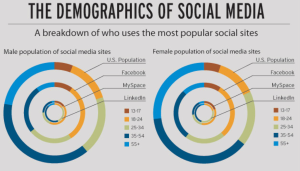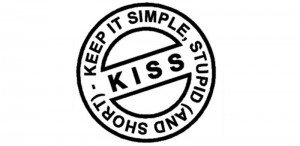Do you have a marketing plan? You don’t? Then you’d better get one. If you don’t have a road map for targeting the right product to the right people in the right way, keep your website on MySpace and start buying truckloads of lottery tickets.
Demographics Do Not Lie
 Demographics is the study of how a population based on factors such as age, race, sex, economic status, education, income, and employment affect various outcomes. Demographics are typically used to learn more about a population’s characteristics. Businesses must rely on demographics as a key method for planning.
Demographics is the study of how a population based on factors such as age, race, sex, economic status, education, income, and employment affect various outcomes. Demographics are typically used to learn more about a population’s characteristics. Businesses must rely on demographics as a key method for planning.
Labor force
Back in 1960, the American labor force was dominated by 21-45 year old white males. Today, we have a far more diverse labor force when viewed according to age, sex, race, and ethnicity. These changes in the labor force require an entirely different structure of practices, strategies, and culture. [Read more…]
Demographics – The Elephant in the Closet
 Several decades ago, I did a long term forecast of the jeans industry. The key predictor in the study was the number of jean purchases by age group. Specifically, kids under 15 wore nothing but jeans. In contrast, no one over 30 wore jeans. We developed various models to show how the jeans market would explode as these kids grew up and continued to wear jeans. You can see the same phenomena today with the Internet. While adults are struggling to keep up with the changes, kids are being raised on apps, search, videos, you tube, social media, game phones, and other devices that they use and develop. It may be difficult to predict precise outcomes, but we know the nature and direction of these trends in future years. Demographics are typically used to learn more about a population’s characteristics and businesses must rely on demographics as a key method for planning. [Read more…]
Several decades ago, I did a long term forecast of the jeans industry. The key predictor in the study was the number of jean purchases by age group. Specifically, kids under 15 wore nothing but jeans. In contrast, no one over 30 wore jeans. We developed various models to show how the jeans market would explode as these kids grew up and continued to wear jeans. You can see the same phenomena today with the Internet. While adults are struggling to keep up with the changes, kids are being raised on apps, search, videos, you tube, social media, game phones, and other devices that they use and develop. It may be difficult to predict precise outcomes, but we know the nature and direction of these trends in future years. Demographics are typically used to learn more about a population’s characteristics and businesses must rely on demographics as a key method for planning. [Read more…]
How Poor Forecasting Can Sabotage Your Business Plan
 How Poor Forecasting Can Sabotage Your Business Plan (And How to Avoid the Pitfalls!)
How Poor Forecasting Can Sabotage Your Business Plan (And How to Avoid the Pitfalls!)
Introduction
I met with a friend recently who shares my interest in launching and funding startups. He told me an interesting story that resonated at many levels. It went something like this:
Back in the 1980s, when he was seeking his first financing, my friend had lunch with a senior partner at one of Silicon Valley’s top venture firms. During lunch, the VC paused, looked my friend, and said,
“There are three types of companies we end up investing in whether we like it or not:
- The “Dead On Arrival” – those who never make it beyond their initial funding before going belly-up
- The “Living Dead” –those who somehow manage to avoid going belly-up, needing more and more investment capital just to stay on life-support, and
- The “Home Runs” those who so far exceed our hopes and expectations it makes all of the others worth the trouble.”
The VC went on… watching my friend wonder which category his company might fit in to.
“Most of our portfolio companies end up in the first two categories — “The Dead and the Un-Dead”… Nine out of ten, I’d say, and these are the ones we didn’t reject off-hand! But, once in a great while, we’re lucky enough to invest in a “Home Run” — a really great startup that helps us to absorb all of the losses from the others, and make a handsome return for our partners and for us. That’s why I’m buying you lunch!”
The VC paused, then asked my friend, “But do you know what one thing all of these companies have in common?” My friend put his fork down and shrugged his shoulders, waiting for the VC’s answer.
The VC smiled and took a deep breath…
“None of these entrepreneurs had the faintest idea about how to realistically forecast their company’s financial performance!”

“If I see another hockey stick forecast this week, I’m going to throw something at somebody.”
Exasperated Venture Capitalist
My friend learned from that lunch what I have also learned in my years of launching and helping fund startups — that few, if any, good investors believe the forecasts presented to them, due mainly to the fact that few entrepreneurs understand the importance of realistic forecasting.
In the words ahead, I will share with you some of the major ways poor forecasting can sabotage your business plan and your financing. I will also share some of the lessons I have learned about how to avoid these pitfalls, and secure the financing you need to launch and grow your enterprise.
Forecasting: The Forgotten Part of the Plan
I frequently read detailed multi-page start up business plans with pages of description and financial detail of every line including details such as paper supplies and print ink. However, one of the most important drivers of the plan — the forecast — is often comprised of a few paragraphs or less. In point of fact, forecasting is often relegated to a minor role in the business plan, and often key elements are overlooked. Examples include:
- One client forecasted a one percent sales growth per week based on what a venture capital firm told her was required for financing
- Clients frequently ignore competition and pricing details, including the role of online distribution such Amazon and Ebay in developing their forecasts
- Market forecasts frequently ignore key market segments and niches. For example, premium customers and products frequently represent less than 10-20% of a plan’s total market. Mass merchants, such as Walmart and Target, can represent 30-60% of a retail product market while boutiques and specialty retailers may be inconsequential.
The process of giving the business plan forecast its deserved place is not easy. This is so for many reasons, including:
- Forecasting is difficult (if not impossible) to do accurately. Key assumptions required for good forecasting are not always evident, and key metrics are not always clear. In the absence of a clear path by which a forecast might be developed, many entrepreneurs gloss over it. For example , the most reliable and recommend tool for forecasting is a company’s own historical track record, which is simply not available for startups.
- Forecasting is easy to over-simplify. The proverbial “Hockey Stick” graph of revenue growth is a classic example of this. The fast growth rate looks impressive on the surface, but the entrepreneur’s lack of restraint leaves the opposite impression with investors. The steeper the pitch of the hockey stick revenue line, the more investors will question the entrepreneur’s business judgment. I read a plan a short time ago that had 20 beautiful pages of financials and charts based and about one paragraph on the assumptions behind the forecast coupled with — you guessed! The Hockey Stick.
- Forecasting is often not based in reality. Demand, competition, market size, pricing, marketing expense, etc., must all be considered, quantified, and explained in developing a solid and credible forecast. For example, the current mantra seems to be that social media networks will generate whatever “buzz” and sales a company needs. However, this argument seldom has a solid explanation regarding how, what, when, and where such meteoric growth in customer awareness and purchasing will occur.
Avoiding the Pitfalls of Poor Forecasting
So how does one develop a good forecast with little market data, no history and a brand new product or service? My approach — developed over many years of experience — is to utilize a variety of time-tested tools, and then to develop a most likely scenario based on the best information available.
Before starting this process, you must learn to avoid what is generally called “confirmation bias.” Here’s where things can easily go wrong in most forecasts and market testing. It’s human nature: we usually test to prove our hunches right. We start our forecasting with a favored option and try to build a case around it. We may deny this tendency, but it is all too common among hopeful entrepreneurs. The result is that the less-favored alternatives usually get short shrift — and these are often the more probable scenarios. The more that there is at stake in the test, the more susceptible we are to Confirmation Bias.
Never state that you have no competition. Such a statement means one of two things to investors: either your business sucks, or you haven’t done your homework and you don’t know your business. Even the most amazing disruptive game-changing plans have competition, if not now, then tomorrow.
Some suggestions for mediating this dilemma are:
- Define your market in terms of products, demographics, region, prices, distribution, and growth, etc.
- Use surrogates like sales per sq. foot, other web sites or other services to develop parameters on your business. For example here is a simple chart for one person providing personal services by hours and rates
Other key elements of realistic market assessments pertaining to your forecasts include:
- Why are you different?
- What is your history or comparisons with competitors?
- What is the market capacity and trending?
- How will marketing generate your sales?
- How will competition react to your initiatives?
- Who might enter the market once you appear on the scene?
A final word about Market Assumptions
The first stage in creating the sales forecast is to estimate Market Demand. Market Demand for a product is the total volume that would be bought by a defined customer group, in a defined geographical area, in a defined time period, in a given marketing environment.
Once you have estimated the total market demand, you can estimate your company’s share of that demand:
Company Demand = Market Demand X Company’s Market Share
The final element in forecasting market demand is to look at future demand for your products or services. Future demand is based on the growth of sales in the industry and changes in the market share.
Sales Forecasting
Accurately predicting future sales is perhaps the most difficult aspect of the forecasting process. This is based on what management expects to happen to the company’s market share, coupled with the estimated demand for the company’s products or services at the proposed price points.
Specific sales forecasts can be based on a integrating a variety of information and efforts:
- Actual customer buying results and attitudes. For example how do price changes , or promotions affect sales on a long and term basis?
- Marketing and brand efforts and long term impact.
- Competitive and distribution changes. For example retail store sales are growing about 1 % a year and internet sales 15-20%.
- What customers have done in the past in the market.
- Time series trends for the market and company.
- Seasonal or cyclical factors. Sales are affected by swings in general economic activity (e.g. increases in the disposable income of consumers may lead to increase in sales for products in a particular industry). Seasonal and cyclical factors occur in a regular pattern;
- Erratic events; these include strikes, fashion fads, war scares, and other disturbances to the market which need to be isolated from past sales data in order to be able to identify the more normal pattern of sales.
Conclusion
“Investors aren’t looking for specific revenue numbers or profit margin benchmarks. What they are looking for is a business strategy that makes good, practical sense. Angels would rather invest in a business with a reasonable shot of generating $20 million in sustainable revenues than the $100 million fantasy.”
Seasoned Angel Investor
- Recognize that the playing field is never level. For example, owners of competing businesses may have more contacts in your industry, they may have access to more capital (deeper pockets), and they may even have a stronger support network of family, friends and investors
- Understand the various factors in your business and market to produce better quality, more accurate, and credible forecasts that support your plans to succeed and grow
- Have a clear marketing strategy. You never know where, when, or how a new prospect is going to hear of your business. If you have a mix of messages out there, the prospects will have an unclear expectation of what your business has to offer. Your company must present a consistent, clear message on all fronts
- Understand pricing and pricing dynamics. Lower prices don’t necessarily mean more customers. Many customers are willing to buy more expensive items because of the greater quality or the added convenience. However many presumed benefits are neither real or relevant, and some intangible benefits are not easily communicated
- Clarify the purpose of your company beyond just making money. This will set the stage for attracting like-minded investors, staff, and strategic partners
- Set specific, measurable, accountable, realistic, and time specific goals to ensure continual progress.
- Even if you have the latest, greatest, never-been-done-before approach to something, don’t assume that you have no competition. Competition is more than just the direct, obvious competitors. Competition is also all the available alternatives
- If you go in expecting to be rich overnight, you may become discouraged early on and give up your dream prematurely. Success takes time, perseverance, and a little bit of luck. Give your business time to grow.
Business Presentation and Image
Business Presentation and Image
Introduction

You only have one chance to make a first impression.
An investor received a knock on his office door and in walked a woman dressed from head to toe as an avocado.
She reached in her bag and handed him a thick business plan about guess what?
Avocados!
The investor shook his head in a “No Way!” gesture, and as he let the woman out, said to her, “Regardless of whether I was interested in what you had to say, I’m not about to do a deal with anyone dressed like an avocado and a plan as thick as a phone book.”
Outrageous as this anecdote may seem, such stories abound in the world of investment and business. Many entrepreneurs fail to realize that a critical factor in startup success is your image and presentation.
And fewer still understand the need for SIMPLICITY.
The Good News?
Creating a professional business presentation and image need not be expensive or complex.
The (potentially) Bad News?
Creating a simple, clear business presentation and image can be very challenging.
Consider the following facts:
- “90% of most impressions are made in the first 30 seconds of contact, and they are not based on the substance of the communication”
- I repeat: “90% of most impressions are made in the first 30 seconds of a meeting and they are not based on the substance of the communication”
- Most people will only spend 2-4 minutes on your website, and the top three places on most Google searches account for 80-90% of the clicks
- Our lives and careers are over-saturated with digital, video, audio, and print content. About the only communication media that are declining are the US mail, catalogues, and newspapers.
The challenges of presenting the right image and making impactful business presentations are crucial to resolve if you want your business to rise above the “chatter.”
If you think I am on to something, read on.
General Considerations
It’s Not About Content
In early business presentations, we frequently become preoccupied with the format and content and we neglect the most important consideration — our Goal and Purpose.
Are we selling something, developing a relationship, impressing the audience, or something else? What is the “take-away,” the “call-to-action” that is actually desired from the audience?
- To buy your product?
- To sign a contract?
- To invest?
For many entrepreneurs, it seems that the “Goal” is:
- To bore the audience
- To put them to sleep, and
- To insure that there won’t be a next meeting.
How to Manage Inevitable Distractions
Let’s say you are presenting to a group and there is someone in the audience who is creating a distraction, or getting you off track with irrelevant questions. You need to remember that it’s YOUR job to manage the business presentation and not allow such distractions to derail you.
The Curse of “Content” — Why “KISS” is the Key
 A few weeks ago, a client and I were discussing how to improve a business presentation because he thought the material was over some of the participants’ head. He insisted on including as much content as possible. He failed to realize that too much information can lead to failure.
A few weeks ago, a client and I were discussing how to improve a business presentation because he thought the material was over some of the participants’ head. He insisted on including as much content as possible. He failed to realize that too much information can lead to failure.
The simple rule: “KISS” applies to almost every business presentation.
One expert uses this rule:
“Create your presentation, then cut it in half… then cut it in half again!”
How Well Do You Really Know Your Audience?
A sure way to avoid the mistake of over-complicating your business presentation is to make sure you understand your audience and their key interests.
Before you develop your business presentation, ask the following questions:
- What is the most important problem my product or service can solve for them?
- How is my product or service superior to others they may be considering?
- How much time do they have for my business presentation?
- Are my business presentation materials engaging and clear?
If you don’t know the answers to these and related questions, don’t be afraid to ask. Use their answers to help decide which benefits to play up in your message, and make it as informative as possible.
Your Image–Remember the Avocado Woman
Another key element of presenting has to do with the image you project to your audience. No matter what the “Avocado Woman” had in her business plan, she failed to create a positive and credible image to her audience.
Here’s where researching your audience and their culture comes in. If you are presenting to a “formal” business culture you may want to wear a suit and tie. A less formal company culture might mean “business casual”. The key is for your audience to feel comfortable.
Business Presentation Goes Beyond the Meeting
Another factor influencing effective presentations has to do with the type, level and timing of follow up. Emails, calls, reminders, etc. are often necessary to improve the chances that the desired call-to-action actually happens. Make sure that you understand your audience’s needs for such follow up, and tailor the type, level, and frequency accordingly.
Don’t Rely on Digital Communications Only
These days we can tend to focus too much on the communication content and not the process of the communication.
Quite simply, we are not always aware of the need for more one-on-one communication, and at times for even informal exchange with our audience as the process evolves.
Such a personal touch will often distinguish you and your company from others. It can also help build understanding and trust, which are often missing from the mass of impersonal emails, auto-responders, spam, pop-up presentations, reports and other “canned” forms of content that dominate much of our lives these days.
Emphasize the Positive—Give them a Glass That’s Half Full
There is no substitute for making your business presentation a “WIN-WIN” with an emphasis upon solutions, problem-solving, and the benefits of doing business with your company.
A win-win environment helps develop support, consensus and shared goals.
Keep your presentation positive, up-beat, and don’t speak poorly of either your competition or your audience’s competitors.
Be sure to respect your audience’s expertise, experience and opinions — this will help insure that you are taken seriously and that you are perceived as being open to new ideas.
Specific Considerations
- Make sure your information is relevant to your audience’s needs and interests.
- Don’t confuse your business presentation with superfluous information. The only thing your audience cares about is whether or not your company can meet their needs.
- Make sure all of your business presentation materials are consistent and professional.
- Give your name, your company name and try to learn the names and roles of those in your audience. Put a signature on your emails with name, website, e-mail address, and phone number.
- Anticipate Technical Issues. Frequently, events are scheduled in tight time slots to justify the expense of taking people away from work. Details such as the date, time, room, equipment, and temperature control can make a big difference.
- Don’t sabotage yourself. Many of the errors I have hi-lighted in this article can be illustrated in a “bad PowerPoint presentation.” There is nothing worse for an audience than having the lights go out and being subjected to a long, irrelevant PowerPoint presentation. If this is your plan, you could save both you and your audience time and effort by cancelling the meeting in advance.
- Take away the risk. Once you’ve built up the desire to have what you sell, you could still lose. Repeat the confidence in the product, yourself, and the company. If possible offer guarantees, samples and assistance with any problems.
- Incorporate informality humor and stories into your presentation. Vary tone, detail and emotion to create interest and avoid boredom.
- Practice appropriate business etiquette. Verbal presentation success is really a function of do’s and don’ts. The most important of these is proper behavior, dress, and courtesy. Learn to say “How are you?” “Please,” and “Thank you.” Look at people when you are speaking with them. Do not interrupt conversations to answer your phones or check text messages.
- Use visual aids, gestures, emotion, and movement to enhance your presentation. Use headlines and graphics your audience cares about
- Close with a Call to Action. Tell your audience what you want them to do after seeing your business presentation. Don’t just assume your audience will look for your phone number or email address and contact you. If you don’t tell them what action to take, they may take the wrong one, including possibly calling another merchant or service provider instead of you.
- Make it easy for your audience to respond. Be sure your name, your business name, your website, email address, and phone number are easily found. I can’t believe how many websites, e-mails, and presentations omit key contact information.
In Summary…
In today’s business environment, we are inundated with unprecedented levels of input in a myriad of formats. LESS IS MORE.
Your audience will first focus on how to filter OUT information—not how to take it in.
Your challenge is to engage your audience so they will want to take your information IN.
I was going to write another 16 paragraphs about this subject, but instead… I decided to “KISS IT”!